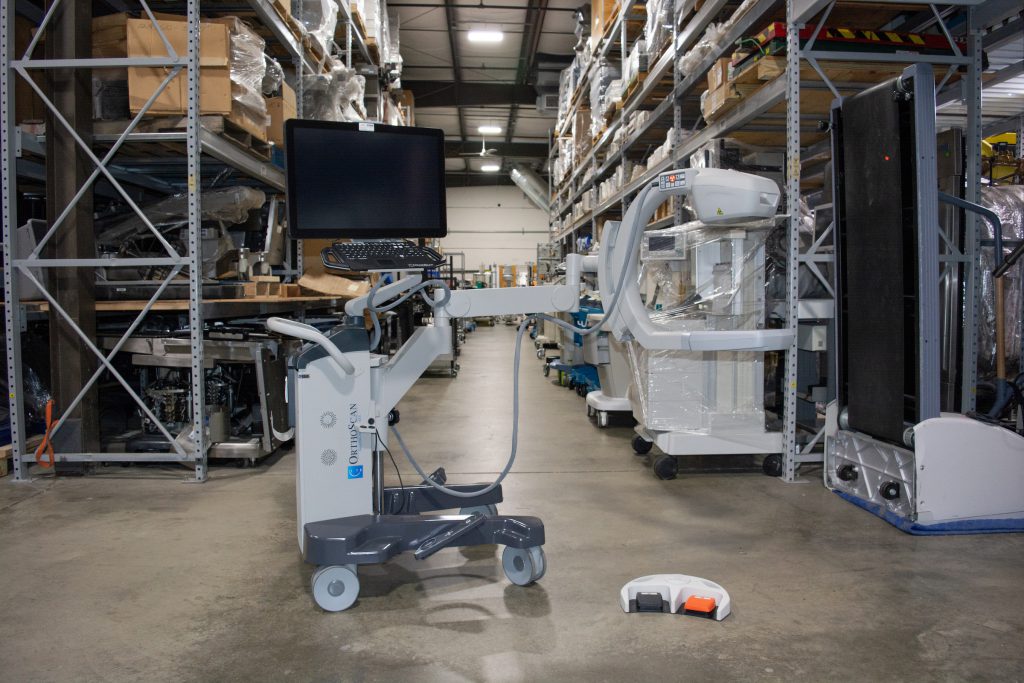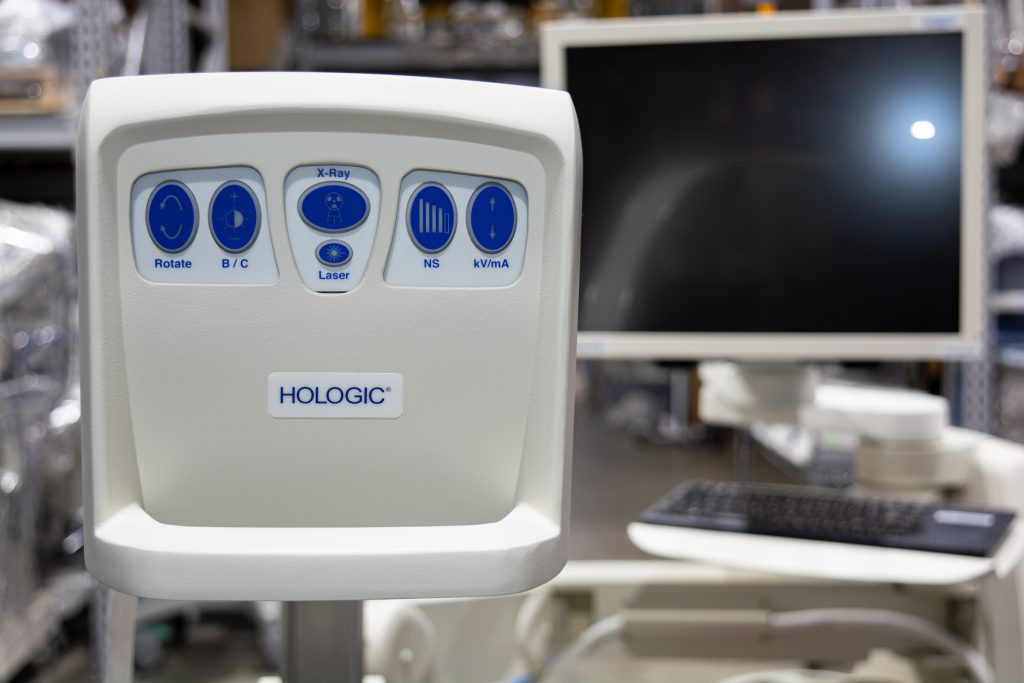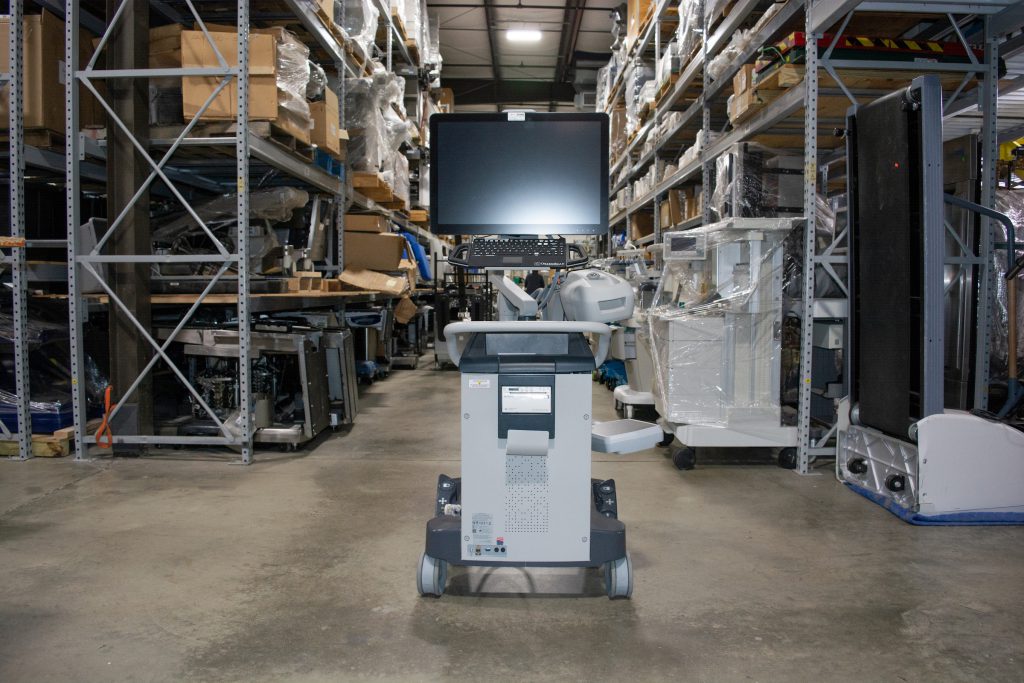Hologic Insight II VS Orthoscan FD Pulse Mini C-Arm
March 25, 2022
- What Is A C-Arm And What Is It Used For?
- General Comparison Between Hologic Insight II And Orthoscan FD Pulse
- Introduction To The Hologic Insight II
- Features Of The Hologic Insight II
- Introduction To The Orthoscan FD Pulse
- Features Of The Orthoscan FD Pulse
- Flat-Panel Detectors VS Image Intensifier
- Top C-Arm Units Available For Rent
- Final Thought
C-Arm systems like the Hologic Insight II and Orthoscan FD Pulse are used for a variety of diagnostic imaging and minimally invasive surgical procedures. In the operating room (OR), they help in visualizing kidney drainage, abdominal and thoracic aortic aneurysm repair, percutaneous valve replacements, cardiovascular surgery, gastroenterology, neurostimulation, orthopedics, pain management, and neurology procedures. Continue reading further to learn more about both the Hologic Insight II and Orthoscan FD Pulse.
WHAT IS A C-ARM AND WHAT IS IT USED FOR?
A mobile C-arm is a medical imaging device that is based on X-ray technology and can be used flexibly in various ORs within hospitals and clinics. The name is derived from the C-shaped arm used to connect the X-ray source and X-ray detector. Since the introduction of the first C-arm in 1955, technology has advanced rapidly. Today, mobile imaging systems are an essential part of everyday hospital life: Specialists in fields such as surgery, orthopedics, traumatology, vascular surgery, and cardiology use C-arms for intraoperative imaging.
The devices provide high-resolution X-ray images in real-time, thus allowing the physician to monitor progress at any point during the operation and immediately make any corrections that may be required. Consequently, the treatment results are better and patients recover more quickly. Hospitals benefit from cost savings through fewer follow-up operations and from minimized installation efforts.
GENERAL COMPARISON BETWEEN HOLOGIC INSIGHT II AND ORTHOSCAN FD PULSE
| Specifications | Hologic Insight II | Orthoscan FD Pulse |
|---|---|---|
| Dimensions (HxW) | 54 x 28 in. (137.16 x 72.12 cm) | 44.5 in. (113.0 cm) |
| C-Arm |
|
|
| Foot Print | 28 x 32 in. (71.1 x 81.3 cm) | 27 x 33 in. (68.6 cm x 83.8 cm) |
| Weight | 495 lbs (224.52 kg) | 400 lbs (181.4 kg) |
| Monitor | Hi-Bright, PCAP touchscreen Hi-Definition 1920 x 1200 Digital DICOM compliant | 24 in. (61 cm) LCD screen |
| Display Size | 24 in. (61 cm), 178° viewing angle | Primary Live Image: 25.4 cm x 25.4 cm (10.0" x 10.0") , Dual Reference Images - 12.7 cm x 12.7 cm (5.0" x 5.0") |
| Modes |
| |
| Image Sensor | Image Intensifier (II) | Flat-Panel Detector (FPD) |
| Imaging |
|
|
| X-Ray Source |
|
|
| Operating System | Window 7 Professional | Windows 8.1 Embedded |
| Connectivity | Ethernet wired, Wireless (optional) | Ethernet wired, Wireless (optional) |
| Image Storage |
|
|
| Printer Option | Sony Thermal Printer UP-898MD (standard format), Sony Hybrid Graphic Printer UP-991AD (large format) | (2) Printer Options |
| Power |
|
INTRODUCTION TO THE HOLOGIC INSIGHT II
The Hologic Fluoroscan Insight II mini c-arm is an intuitive easy-to-use, cost-effective system designed specifically for the orthopedic and extremity imaging market. With high-quality digital images, simplified operation, and easy mobility, the system is the ideal choice for the operating room, emergency department, surgery center, and doctor’s office. The Hologic Insight II has a standard 6”/4” image intensifier and delivers ultra-fine, low-dose fluoroscopy, and snap-shot images.
New system enhancements have been made to help you see more; a 24” high-definition, hi-bright monitor paired with MegaView™ Image ensures you see your images at their largest and sharpest – even from a distance. The system’s fully automated and customizable acquisition makes it the perfect addition to any healthcare facility.
FEATURES OF THE HOLOGIC INSIGHT II
Features of the Hologic Insight II include:
- Three imaging modes: Snapshot (Single Shot), Continuous (Fluoro), and Cine (Digital) Recorded Fluoro
- Auto edge enhancement
- Auto-dose control
- Brightness/contrast control
- Automated image processing
- Auto real-time noise reduction
- A permanent hard drive that stores up to 8,000 images
- Footswitch options include wired triple-function footswitch, wireless triple-function infrared footswitch, and configurable save/tag
- Ultra-fine low-dose fluoroscopy that produces high-resolution images
INTRODUCTION TO THE ORTHOSCAN FD PULSE
The OrthoScan FD Pulse is the first and only mini C-arm with pulsed fluoroscopy. The FD Pulse provides dose reduction with state-of-the-art image quality. The square-shaped CMOS flat-detector provides the greatest field of view, enabling the user to see more anatomy. This flat detector design and compact form factor allow optimal positioning in the surgical environment. Surgical lights on the undersurface of the X-ray source reduce shadows by providing primary light in the surgical field, illuminating anatomical detail.
FEATURES OF THE ORTHOSCAN FD PULSE
Some unique features of the Orthoscan FD Pulse include:
- The advanced OrthoTouch™ user interface allows seamless operation of system controls while still allowing for keyboard functions.
- With FD Pulse, the 24″ high-resolution diagnostic widescreen monitor allows for a 20% larger viewing area.
- Moving from continuous fluoroscopy to pulsed fluoroscopy of 30 pulses per second (PPS), OrthoScan can reduce the dose without loss of image quality or detail.
- A larger detector provides the greatest field of view, enabling the user to see more anatomy.
- The design allows for an orbital rotation of 150°. This enables the user to take advantage of the larger field of view without making mechanical adjustments.
- Flat detectors provide increased image quality, improved reliability, a smaller footprint, and more efficient imaging when compared to older image intensifier technology.
- Located on the bottom of the tube head, these surgical lights provide additional illumination on the anatomy and eliminate shadows cast from the C.
- Conveniently located on each side of the tube head assembly, bilateral controls provide easy access to imaging and documentation in the sterile field.
FLAT-PANEL DETECTORS VS IMAGE INTENSIFIERS
Flat-panel detectors (FDP) are increasingly replacing image intensifiers (II) on mobile C-arm systems, part of a migration of technology once available only in fixed room systems. The advantages of this technology include:
- lower patient dose
- increased image quality
- no deterioration of the image quality over time
Despite FDP’s higher cost, the noteworthy changes in the physical size and accessibility for the patients are worth it. Ultimately, flat panel detectors and image intensifiers each have their strengths. It’s up to you to determine what your needs are and which system has the right qualifications for your facility.
TOP C-ARM UNITS AVAILABLE FOR RENTAL
Here at Soma Tech Intl, we have rental options widely available that can allow hospitals to remain within their budget, and on track with their patient census and healthcare options. C-Arm equipment such as the Hologic Insight II, Orthoscan FD Pulse, and many more are rentable for a short or long term with the option to own.
If your facility is interested in C-Arm imaging systems or any other medical equipment rentals, please contact your local sales representative. Each sales representative is more than willing to listen to your clinical needs and make recommendations on which machines to rent. For any further inquiries, you can also contact us at 1.800.GET.SOMA or send us an email at [email protected].
FINAL THOUGHT
It is without a doubt the significant importance of c-arms for orthopedic, urology, gastroenterology surgeries, pain management, cardiac, angiography and therapeutic studies, and other complicated surgical procedures. Regardless of the difference between flat-panel and image intensifiers, both the Hologic Insight II and Orthoscan FD Pulse are amongst the most sought-after mini c-arm units. Have you ever worked with either imaging unit before? What features are the most important factors in choosing the ideal c-arm unit? Did you find this article helpful? Please leave us a comment below!
Explore Other Blog Items By Category
Recent Posts


Surgical Microscope Rentals









